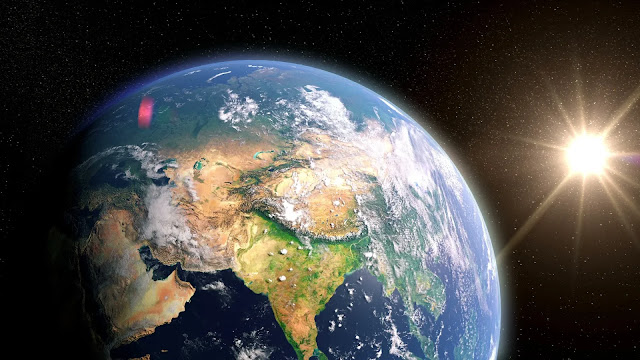 |
| Indian Subcontinent from Space |
A Continent on the Move: Understanding Tectonic Plates
Our planet's crust is not a single, rigid shell. Instead, it's fractured into giant, constantly moving slabs called tectonic plates. These plates grind against, slide under, and occasionally collide with each other, shaping continents and causing earthquakes and volcanic eruptions.
The Indian Plate's Journey: From Gondwana to Potential Split
The Indian Plate was once part of the supercontinent Gondwana. Approximately 100 million years ago, it began its northward journey, eventually colliding with the Eurasian Plate, a monumental event that gave birth to the Himalayas. However, a new theory suggests a potential twist in this tale.
The Smoking Gun: Evidence of a Splitting Plate
Researchers analyzing earthquake waves traveling beneath the Tibetan Plateau have found intriguing signs. The data suggests a possible "delamination" – the Indian Plate's denser bottom layer peeling away and sinking deeper into the Earth's mantle, while the lighter upper layer continues its northward push. This could be the initial stage of the plate splitting into two distinct sections.
Potential Causes of the Split: A Multifaceted Issue
Several factors might be contributing to this phenomenon:
- Collision with Eurasia: The immense force exerted by the Indian Plate against Eurasia could be causing internal stresses that lead to a split.
- Subduction at the Eastern Himalayas: As the Indian Plate subducts (dives) under the Eurasian Plate in the eastern Himalayas, it might be experiencing uneven pressure distribution, triggering a tear.
- Mantle Convection Currents: The churning of the Earth's mantle, a layer of hot, molten rock below the crust, could be exerting forces that contribute to the split.
A Splitting Timeline: Catastrophe or Gradual Shift?
The timeframe for a complete split, if it occurs at all, is a subject of ongoing debate. Estimates range from millions to tens of millions of years. The initial delamination might not lead to a complete separation but could significantly alter the geological landscape of the region.
Impact on India and Beyond: A Global Chain Reaction
A splitting Indian Plate could have far-reaching consequences:
- Increased Seismic Activity: The process could trigger more frequent and intense earthquakes in India, Nepal, and surrounding areas.
- Shifting Landscapes: The reshaping of the plates could lead to changes in sea levels, flooding, and the formation of new mountain ranges.
- Climate Change: Altered ocean currents and volcanic activity could disrupt global weather patterns.
The World Watches: Scientific Inquiry and Collaborative Response
While the potential split is a cause for concern, it's important to remember that this is an ongoing area of research. Further studies using sophisticated seismic and geological techniques are needed to confirm the theory and refine the timeline. International collaboration and scientific advancements will be crucial in understanding and mitigating the potential consequences.
Conclusion: A Continent in Flux
The theory of the Indian Plate splitting presents a fascinating and potentially impactful geological scenario. While the timeline for such an event remains uncertain, continued research is essential. By understanding the science behind this phenomenon, we can prepare for potential challenges and ensure a more sustainable future for India and the entire planet.
